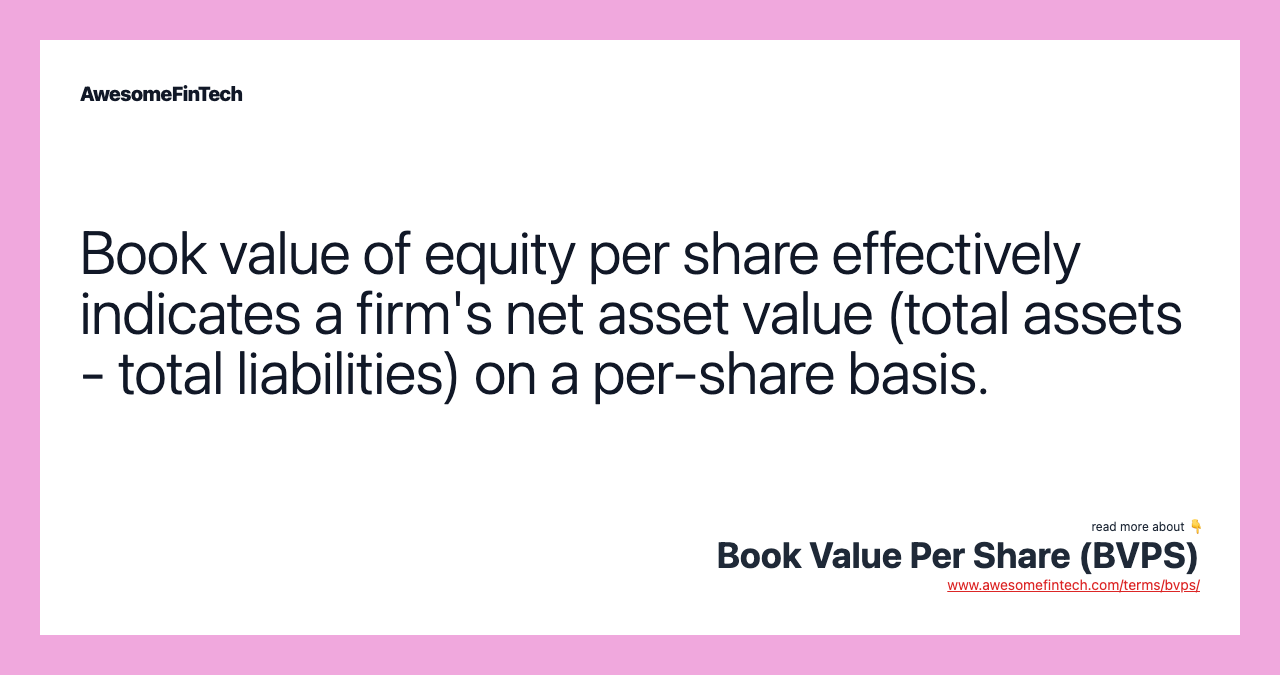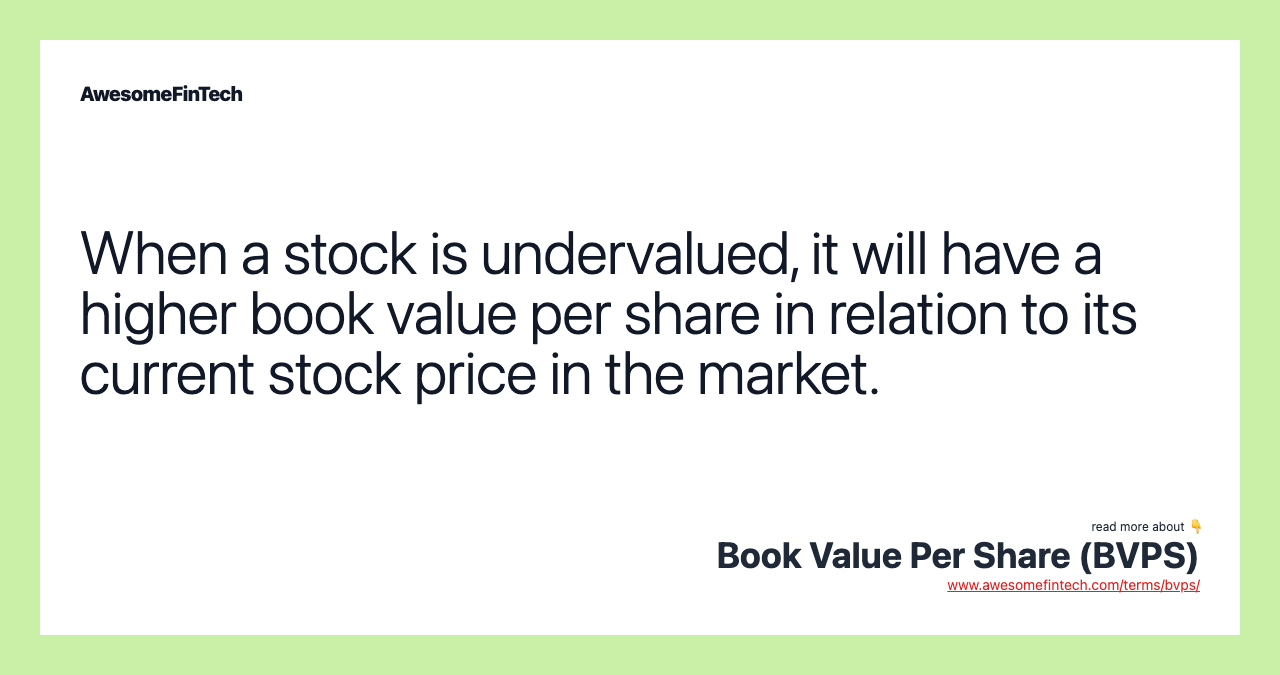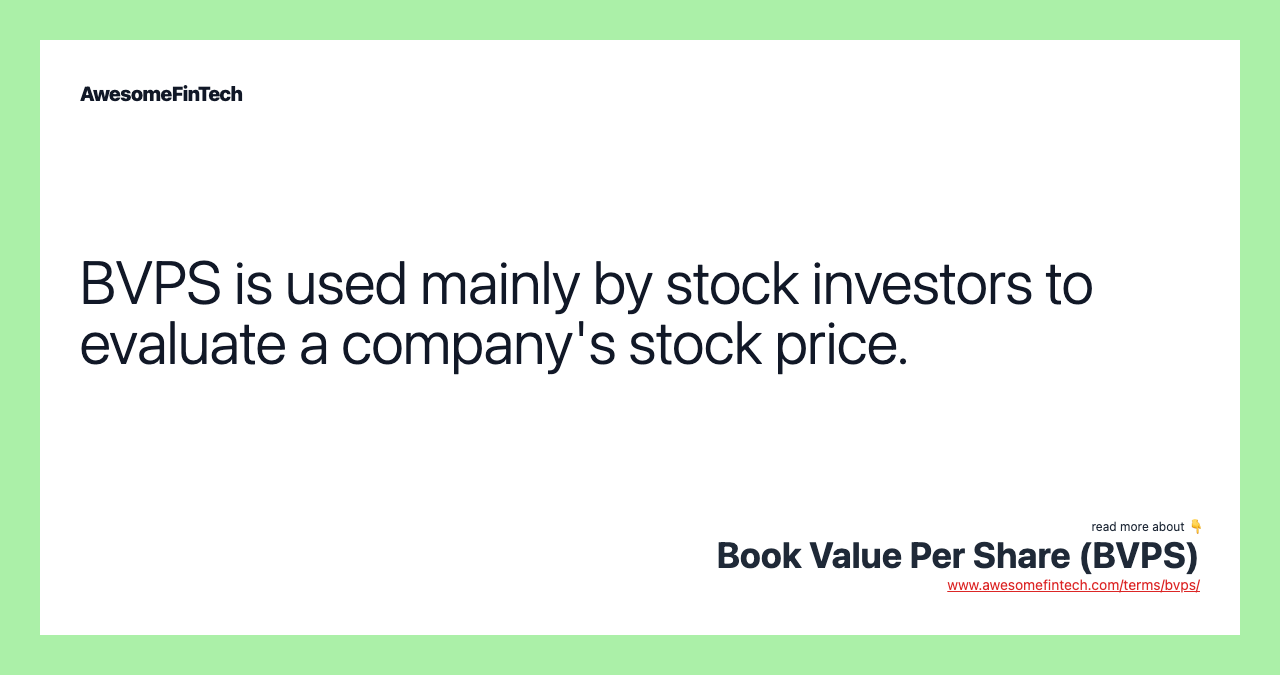Book Value Per Share (BVPS)
Book value per share (BVPS) is the ratio of equity available to common shareholders divided by the number of outstanding shares. Since preferred stockholders have a higher claim on assets and earnings than common shareholders, preferred stock is subtracted from shareholders' equity to derive the equity available to common shareholders. Assume, for example, that XYZ Manufacturing’s common equity balance is $10 million, and that 1 million shares of common stock are outstanding. 1:18 The book value per share (BVPS) metric can be used by investors to gauge whether a stock price is undervalued by comparing it to the firm's market value per share. However, as the assets would be sold at market prices, and book value uses the historical costs of assets, market value is considered a better floor price than book value for a company. If a company’s BVPS is higher than its market value per share — its current stock price — then the stock is considered undervalued.

What Is Book Value Per Share (BVPS)?
Book value per share (BVPS) is the ratio of equity available to common shareholders divided by the number of outstanding shares. This figure represents the minimum value of a company's equity and measures the book value of a firm on a per-share basis.




Understanding Book Value Per Share (BVPS)
The book value per share (BVPS) metric can be used by investors to gauge whether a stock price is undervalued by comparing it to the firm's market value per share. If a company’s BVPS is higher than its market value per share — its current stock price — then the stock is considered undervalued. If the firm's BVPS increases, the stock should be perceived as more valuable, and the stock price should increase.
In theory, BVPS is the sum that shareholders would receive in the event that the firm was liquidated, all of the tangible assets were sold and all of the liabilities were paid. However, as the assets would be sold at market prices, and book value uses the historical costs of assets, market value is considered a better floor price than book value for a company.
If a company's share price falls below its BVPS, a corporate raider could make a risk-free profit by buying the company and liquidating it. If book value is negative, where a company's liabilities exceed its assets, this is known as a balance sheet insolvency.
The formula for BVPS is:
B V P S = Total Equity − Preferred Equity Total Shares Outstanding BVPS\ =\ \frac{\text{Total Equity}\ -\ \text{Preferred Equity}}{\text{Total Shares Outstanding}} BVPS = Total Shares OutstandingTotal Equity − Preferred Equity
Shareholders’ equity is the owners’ residual claim in the company after debts have been paid. It is equal to a firm's total assets minus its total liabilities, which is the net asset value or book value of the company as a whole.
Since preferred stockholders have a higher claim on assets and earnings than common shareholders, preferred stock is subtracted from shareholders' equity to derive the equity available to common shareholders.
Example of Book Value Per Share
Assume, for example, that XYZ Manufacturing’s common equity balance is $10 million, and that 1 million shares of common stock are outstanding. This means that the BVPS is ($10 million / 1 million shares), or $10 per share. If XYZ can generate higher profits and use those profits to buy more assets or reduce liabilities, the firm's common equity increases.
If, for example, the company generates $500,000 in earnings and uses $200,000 of the profits to buy assets, common equity increases along with BVPS. If XYZ uses $300,000 of its earnings to reduce liabilities, common equity also increases.
Another way to increase BVPS is to repurchase common stock from shareholders. Many companies use earnings to buy back shares. Using the XYZ example, assume that the firm repurchases 200,000 shares of stock and that 800,000 shares remain outstanding. If common equity is $10 million, BVPS increases to $12.50 per share. Besides stock repurchases, a company can also increase BVPS by taking steps to increase the asset balance and reduce liabilities.
Market Value Per Share vs. Book Value Per Share
While BVPS is calculated using historical costs, the market value per share is a forward-looking metric that takes into account a company's future earning power. An increase in a company’s potential profitability or expected growth rate should increase the market value per share.
For example, a marketing campaign will reduce BVPS by increasing costs. However, if this builds brand value and the company is able to charge premium prices for its products, its stock price might rise far above its BVPS.
What Does Book Value Per Share (BVPS) Tell You?
In theory, BVPS is the sum that shareholders would receive in the event that the firm was liquidated, all of the tangible assets were sold and all of the liabilities were paid. However, its value lies in the fact that investors use it to gauge whether a stock price is undervalued by comparing it to the firm's market value per share. If a company’s BVPS is higher than its market value per share, which is its current stock price, then the stock is considered undervalued.
How Can Companies Increase BVPS?
A company can use a portion of its earnings to buy assets that would increase common equity along with BVPS. Or, it could use its earnings to reduce liabilities, which would also result in an increase in its common equity and BVPS. Another way to increase BVPS is to repurchase common stock from shareholders and many companies use earnings to buy back shares.
How Does BVPS Differ from Market Value Per Share?
While BVPS is calculated using historical costs, the market value per share is a forward-looking metric that takes into account a company's future earning power. An increase in a company’s potential profitability or expected growth rate should increase the market value per share. Essentially, the market price per share is the current price of a single share in a publicly traded stock. Unlike BVPS, market price per share is not fixed as it fluctuates based solely on market forces of supply and demand.
Related terms:
Book
A book is a record of all the positions that a trader is holding, showing the quantity of longs and shorts in each security. read more
Book Value : Formula & Calculation
An asset's book value is equal to its carrying value on the balance sheet, and companies calculate it by netting the asset against its accumulated depreciation. read more
Book Value Per Common Share - BVPS
Book value per common share (BVPS) derives a company's book value on a per-share basis. read more
Earnings Power
Earnings power is a business's ability to generate profit from conducting its operations. read more
Graham Number
The Graham number is the upper bound of the price range that a defensive investor should pay for a stock. read more
Market Value
Market value is the price an asset gets in a marketplace. Market value also refers to the market capitalization of a publicly traded company. read more
Outstanding Shares
Shares outstanding refer to a company's stock currently held by all its shareholders, including share blocks held by institutional investors and restricted shares owned by the company’s insiders. read more
Price-To-Book Ratio (P/B Ratio)
The price-to-book ratio (P/B ratio) evaluates a firm's market value relative to its book value. read more
Shareholder Equity (SE)
Shareholder equity (SE) is the owner's claim after subtracting total liabilities from total assets. read more